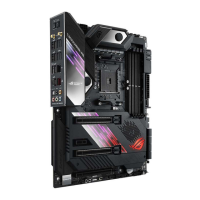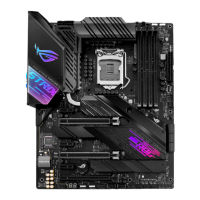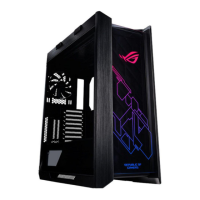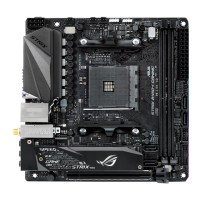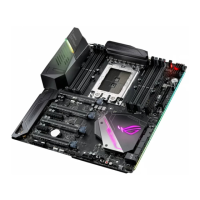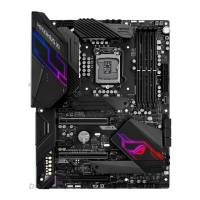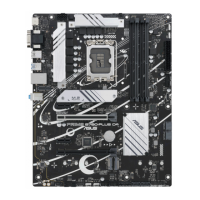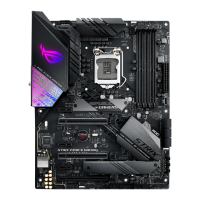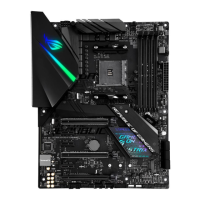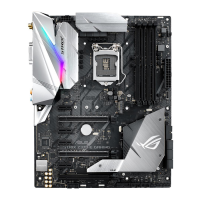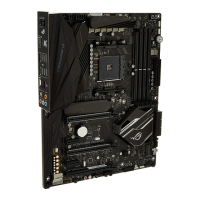
Do you have a question about the Asus rog crosshair vii hero and is the answer not in the manual?
| Non-ECC | Yes |
|---|---|
| Memory channels | Dual-channel |
| Memory slots type | DIMM |
| Number of memory slots | 4 |
| Supported memory types | DDR4-SDRAM |
| Maximum internal memory | 64 GB |
| Supported memory clock speeds | 2133, 2400, 2666, 2800, 2933, 3000, 3200, 3466 MHz |
| Processor socket | Socket AM4 |
| Processor manufacturer | AMD |
| Compatible processor series | AMD Athlon X4, AMD Ryzen 3, AMD Ryzen 3 2nd Gen, AMD Ryzen 3 3rd Gen, AMD Ryzen 5, AMD Ryzen 5 2nd Gen, AMD Ryzen 5 3rd Gen, AMD Ryzen 7, AMD Ryzen 7 2nd Gen, AMD Ryzen 7 3rd Gen, AMD Ryzen 9 3rd Gen |
| USB 2.0 connectors | 2 |
| Number of SATA III connectors | 6 |
| Number of Parallel ATA connectors | 0 |
| USB 3.2 Gen 1 (3.1 Gen 1) connectors | 1 |
| RAID levels | 0, 1, 10 |
| Supported storage drive types | HDD & SSD |
| Supported storage drive interfaces | M.2, PCI Express 3.0, SATA III |
| USB 2.0 ports quantity | USB 2.0 ports have a data transmission speed of 480 Mbps, and are backwards compatible with USB 1.1 ports. You can connect all kinds of peripheral devices to them. |
| USB 3.2 Gen 1 (3.1 Gen 1) Type-A ports quantity | 8 |
| USB 3.2 Gen 1 (3.1 Gen 1) Type-C ports quantity | - |
| LAN controller | Intel® I211-AT |
| Ethernet interface type | Gigabit Ethernet |
| Component for | PC |
| Motherboard chipset | AMD X470 |
| Audio output channels | 8.0 channels |
| Motherboard form factor | ATX |
| Windows operating systems supported | Windows 10 Education x64, Windows 10 Enterprise x64, Windows 10 Home x64, Windows 10 Pro x64 |
| Parallel processing technology support | 2-Way SLI, 3-Way CrossFireX, CrossFireX |
| BIOS type | UEFI AMI |
| ACPI version | 6.0 |
| BIOS memory size | 256 Mbit |
| System Management BIOS (SMBIOS) version | 3.0 |
| Cables included | SATA |
| Harmonized System (HS) code | 84733020 |
| Depth | 244 mm |
|---|---|
| Width | 305 mm |
Covers safety measures during system handling and operation, including electrical shock prevention.
Explains the manual's organization and points to further resources for product updates.
Defines warning symbols and text formatting conventions used throughout the manual.
Details CPU socket compatibility and chipset information.
Covers RAM capacity, type, and PCIe slot details.
Explains SLI and CrossFireX compatibility for multiple graphics cards.
Details M.2/SATA storage interfaces and high-definition audio CODEC features.
Covers LAN port specifications and Wi-Fi/Bluetooth connectivity.
Lists USB 3.1 Gen 1/Gen 2 and USB 2.0 ports on the motherboard.
Highlights unique features like Extreme Engine Digi+ and ASUS Q-Design.
Describes special features, ASUS EZ DIY, Gamer’s Guardian, and Q-Design.
Lists and describes all rear panel connectors for external connectivity.
Details all internal connectors and headers on the motherboard for system building.
Covers BIOS capabilities, manageability features, and software utilities.
Specifies OS compatibility and the motherboard's physical dimensions.
Lists all items included with the motherboard, such as cables and accessories.
Identifies necessary tools and optional hardware for motherboard setup.
Introduces the motherboard and essential safety steps before installation.
Illustrates the physical layout and identifies major motherboard connectors.
Provides a comprehensive breakdown of motherboard controls and ports.
Explains the AM4 socket and proper CPU installation procedures.
Details DDR4 DIMM slots and recommended memory setups.
Describes PCIe slots and their operating modes based on CPU.
Explains the function of onboard buttons, switches, and diagnostic LEDs.
Details SATA, USB front panel, audio, and ROG extension connectors.
Covers various fan/pump headers and ATX power connectors.
Explains connections for RGB lighting strips.
Guides on installing M.2 SSDs into the motherboard sockets.
Describes the ProbeIt points for monitoring system voltages.
Introduces PC assembly and the initial CPU installation process.
Details mounting CPU heatsinks and AIO coolers.
Guides on physically mounting the motherboard within the PC case.
Explains how to install and remove memory modules correctly.
Covers connecting the main power supply and storage devices.
Details connecting front panel components and installing expansion cards.
Guides on installing M.2 SSDs into the motherboard.
Explains how to connect the Wi-Fi antennas to the motherboard.
Details updating the BIOS using the USB BIOS Flashback feature.
Describes rear ports and setting up audio connections.
Guides on initial power-on and interpreting BIOS beep codes.
Explains the purpose of BIOS and how to navigate its interface.
Introduces Advanced Mode and details menu bar items like search and AURA.
Covers EZ Mode for basic settings and Q-Fan for fan speed management.
Explains how to use the wizard for automatic CPU and DRAM tuning.
Details system info, security settings, and personalizing BIOS with My Favorites.
Covers CPU and memory overclocking options like Ai Overclock Tuner and BCLK.
Details CPU settings, SATA modes, and configuring onboard devices.
Covers power management, network, storage, and NVMe configurations.
Explains system monitoring features and fan/pump control.
Details boot device priority, Fast Boot, and Compatibility Support Module settings.
Covers BIOS flashing utility and SSD secure erase function.
Explains Windows-based update utility and BIOS recovery tool.
Introduces RAID support and defines different RAID levels.
Lists and explains various Q-Code error codes for troubleshooting.
Provides regulatory compliance information for different regions.
Covers environmental compliance and safety warnings.
Displays the license terms for Google software components.

